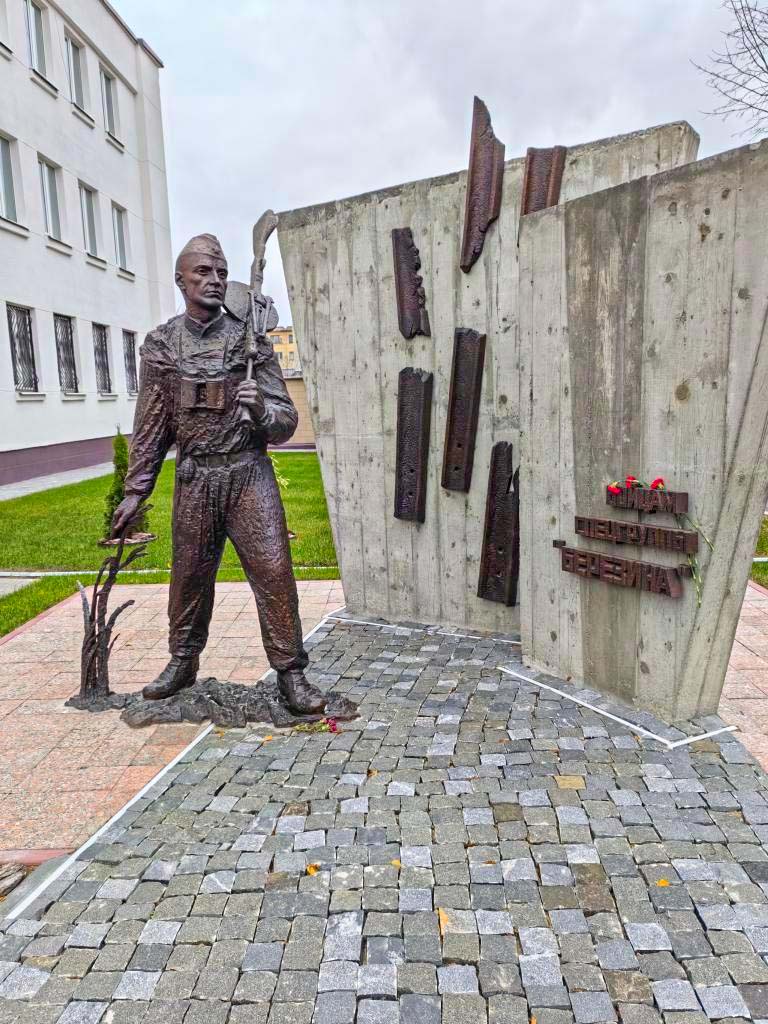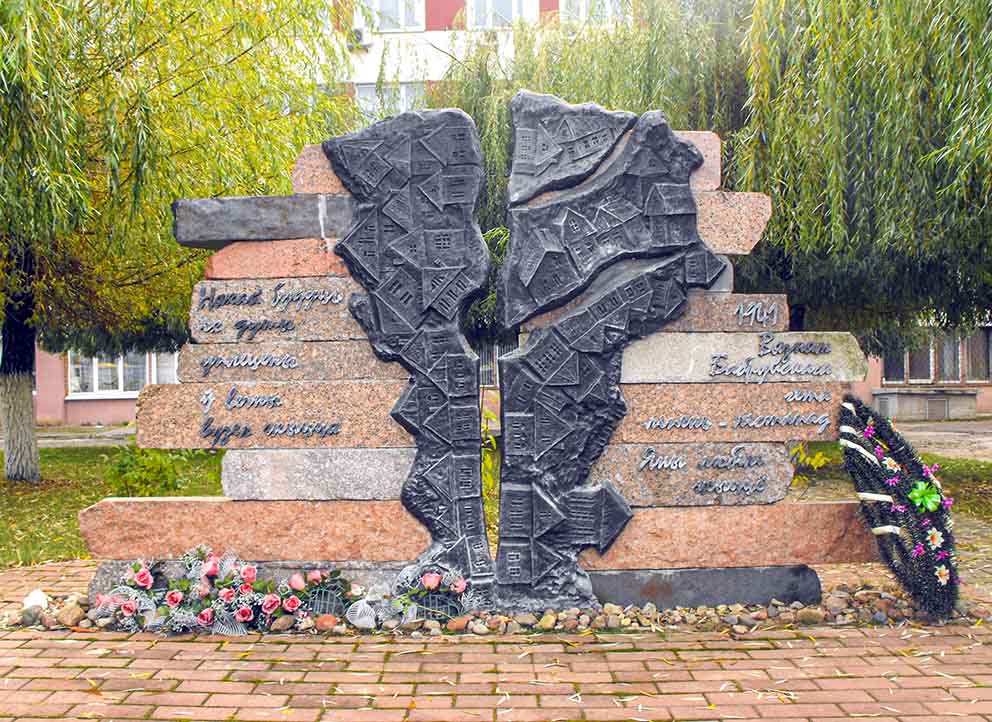
Monument to partisans and underground members on the mass grave of underground members in Babrujsk city.

Monument on the mass grave of Soviet war prisoners and fascism victims in Dzimitrava vulitsa in Babrujsk city.

Monument in honour of the military units which distinguished themselves during the liberation of Babrujsk city.
Babrujsk
City, centre of Babrujsk Rajon, Magiliow Voblasc, hithe on the Biarezina River. 110 km southwest of Magiliow, 150 km from Minsk; railways junction (lines to Zhlobin, Asipovichy, Akciabrski) and highways junction (to Minsk, Magiliow, Ragachow, Zhlobin, Kalinkavichy, Sluck).
In 1944–1954, centre of Babrujsk Voblasc.
In 1939, 84,078 inhabitants lived in Babrujsk.
As early as June 22, 1941, Babrujsk was bombarded by German Nazi aircraft.
Babrujsk was invaded on June 28, 1941, when Soviet troops were forced to leave the city.
On the eastern bank of the Biarezina in the Babrujsk area, fierce fighting continued for another three days. The Svislach — Babrujsk — Parychy defensive line was held by the units of the 47th Rifle Corps, the 121st Rifle Division, cadets of the Tractor Training School (deputy head of the school was colonel D. S. Chuprygin), the Road Maintenance Regiment (total of 3.7 thousand people) under the overall command of commander of the 47th Rifle Corps, major general S. I. Povetkin. They were supported by the 117th Independent Anti-Tank Guns Battalion of the 68th Rifle Corps. On June 29, part of the forces of the German 3rd and 4th Tank divisions of H. Guderian forced in crossing the Biarezina near Shchatkava and Damanava villages (to the north and south of the city) but were expelled from the captured bridgeheads. On June 30, the assault detachment of Soviet soldiers crossed over the Biarezina and took control of the Babrujsk Fortress but without receiving help had to leave it. On June 30, in the Shchatkava area, German tanks forced in crossing over the Biarezina along the bottom of the river. The enemy expanded the bridgehead, transferred the main forces of the 3rd Tank Division, motorised infantry and artillery there, and with the assistance of the aviation attacked the flank units of Soviet troops. Under the onslaught of much larger enemy forces, Soviet troops retreated from this line and took up defence on the Ala River on July 1, later they dropped back to Ragachow town.
The invaders formed 4 death camps with eight branches and departments in the city, killed more than 44,000 local residents (including up to 25,000 in the ghetto) and 40,000 war prisoners (see Babrujsk death camp) in the city and its surroundings, 15 thousand people were taken to hard labour to Germany. On the eve of the liberation in June 1944, 28,000 inhabitants remained in the city.
During the occupation, the German Nazi invaders destroyed Babrujsk, demolished all industrial enterprises. The city became an important stronghold of the enemy army where military units were assembled and formed, and punitive intelligence structures operated.
The Babrujsk Party-Komsomol Underground, Babrujsk Underground Interrajon Committee of the Communist Party (Bolsheviks) of Belarus, Babrujsk Underground Rajon Committee of the Communist Party (Bolsheviks) of Belarus, Babrujsk Underground Interrajon Committee of the Leninist Young Communist League of Belarus, Babrujsk Underground City Committee of the Leninist Young Communist League of Belarus, Babrujsk Underground Rajon Committee of the Leninist Young Communist League of Belarus operated in the city and rajon. The 1st Babrujsk Partisan Brigade, 12th Cavalry J. V. Stalin Partisan Brigade, “Za Radzimu” (for the Motherland) A. K. Flegontov Partisan Brigade, 37th A. Ja. Parkhomenko Partisan Brigade, the 537th Partisan Regiment, the 100th Partisan Detachment, 225th Partisan Detachment, 540th Partisan Detachment, Partisan Detachment under P. A. Dudaĺ, “Khrabratsy” (brave men) Partisan Detachment operated in the rajon. The Bobrujskij Partizan («Бобруйский партизан», lit. ‘Babrujsk partisan’) underground newspaper, i.e. the body of the Babrujsk Underground Rajon Committee of the Communist Party (Bolsheviks) of Belarus, was published.
On June 29, 1944, Babrujsk was liberated by the soldiers of the 108th Rifle Division (major general P. A. Teremov) of the 41st Rifle Corps; the 23rd (Lt.Col. K. I. Bojka), 95th (colonel A. I. Kuznetsov) and 108th (Lt.Col. V. N. Baraniuk) Tank brigades; the 8th Motorised Rifle Brigade (Lt.Col. P. I. Trushkin) of the 9th Tank Corps of the 3rd Army; the 137th (major general F. N. Zhabrev) and 399th (major general D. V. Kazakevich) Rifle divisions of the 42nd Rifle Corps; the 217th (colonel N. P. Massonov) and 102nd (colonel M. P. Pagrabniak) Rifle divisions of the 29th Rifle Corps; the 42nd Independent Tank Regiment (Lt.Col. S. I. Tideman); the 713th (Lt.Col. I. V. Vasilev), 1890th (Lt.Col. S. F. Balykov), and 1897th (Lt.Col. M. F. Ryzhanov) Self-Propelled Artillery regiments; the 13th Light (colonel E.Ja. Pukhov), 59th Cannon (colonel A. I. Jurgielievich), and 63rd Howitzer (colonel K. A. Papa) Artillery brigades of the 22nd Breakthrough Artillery Division of the 48th Army; the 354th (colonel S. A. Vdovin) and 356th (major general M. G. Makarov) Rifle divisions; the 115th Independent Rifle Brigade (colonel A. N. Volkov) of the 105th Rifle Corps; the 15th (colonel K. G. Kazhanov), 16th (colonel P. A. Limarenka), and 17th (colonel B. V. Shulgin) Guards Tank brigades; the 1st Guards Motorised Rifle Brigade (major general G. N. Filippov) of the 1st Guards Tank Corps; the 354th Guards Heavy (major G. V. Volkov) and 922nd Light (Lt.Col. A. V. Sokolov) Self-Propelled Artillery regiments of the 65th Army; the 1st River Ships Brigade (captain of the 2nd rank S. M. Liaĺko) of the Dniapro River Military Flotilla; the units of the 8th Fighter Aviation Corps (lieutenant general of Aviation A. S. Osipenko) composed of two aviation divisions; the 6th Mixed Aviation Corps (colonel M. Kh. Barysienka) composed of one fighter and two bomber aviation divisions; the 3rd Bomber Aviation Corps (major general of Aviation A. Z. Karavatskij) composed of two aviation divisions and 1st Guards Fighter Aviation Division (Lt.Col. U. V. Sukharabaw) of the 16th Air Army with the participation of the Long-Range Aviation of the 1st Belarusian Front in the course of the Babrujsk offensive of 1944. 20 military units and formations that liberated Babrujsk (see Babrujsk Military Formations and Units) were awarded the Babrujsk honorary title.
In Babrujsk, there are:
mass graves of Soviet soldiers; ones of Soviet soldiers and partisans; ones of underground members; ones of Soviet war prisoners and fascism victims; grave of fascism victims; monuments were placed on these graves;
the To the Victims of Fascism memorial complex at the mass grave of Soviet war prisoners and fascism victims;
memorial complex at Victory Square where 6 Soviet soldiers were buried, including major general B. S. Bakharov, with the tank monument raised on his grave;
memorial in honour of the soldiers who died during the liberation of the city from German Nazi invaders (raised on the mass grave of Soviet soldiers in the city cemetery, includes the Saint George monument);
memorial of combat glory in honour of the Dniapro tankers;
monument to Soviet liberators;
monument to Soviet tankers;
monument in honour of the military units which distinguished themselves during the liberation of Babrujsk;
monument to the soldiers of the 1st Belarusian Front (in honour of the liberation of the city);
monuments to the V. I. Lenin Machine-Building Plant and the Plywood and Wood Processing Plant workers who died in the struggle against German Nazi invaders;
monument to the Babrujsk partisans and underground members who died during the Great Patriotic War;
monument to Hero of the Soviet Union V. Z. Kharuzhaja;
memorial sign in honour of the Dniapro River Military Flotilla;
the To the Prisoners of the Babrujsk Ghetto memorial sign;
the From Life to Life memorial sign (to the victims of the Holocaust);
memorial sign in honour of the 108th Babrujsk Rifle Division;
memorial sign in honour of the inhabitants of Babrujsk who died at the fronts and in the enemy’s rear during the Great Patriotic War;
memorial sign in honour of the soldiers of the People’s Commissariat of State Security’s Biarezina Special Group;
memorial sign in honour of perpetuating the memory of former workers of the Bielshyna AAT (OJSC) who participated in the Great Patriotic War);
Alley of Righteous (in honour of the Belarusians who saved the Jews);
Alley of Heroes;
memorial plaques to underground members, Heroes of the Soviet Union P. I. Batov, K. P. Arlowski, U. I. Jarmak, D. M. Karbyshev.
By Decree of the President of the Republic of Belarus № 355 dd. June 29, 2009, Babrujsk city was awarded the ‘For Courage and Fortitude During the Great Patriotic War’ pennant.









Беларусь у Вялікай Айчыннай вайне, 1941–1945: энцыклапедыя / Рэдкал.: І. П. Шамякін (гал. рэд.) [і інш.]. – Мінск: Беларуская Савецкая Энцыклапедыя імя Петруся Броўкі, 1990.
Збор помнікаў гісторыі і культуры Беларусі. Магілёўская вобласць / Рэдкал.: С. В. Марцэлеў (гал. рэд.) [і інш.]. – Мінск: Беларуская Савецкая Энцыклапедыя імя Петруся Броўкі, 1986.
Энцыклапедыя гісторыі Беларусі: у 6 т. Т. 1: А—Беліца / Рэдкал.: М. В. Біч [і інш.]. – Мінск: Беларуская Энцыклапедыя імя Петруся Броўкі, 1993.
Беларуская энцыклапедыя: у 18 т. Т. 2: Аршыца—Беларусцы / Рэдкал.: Г. П. Пашкоў (гал. рэд.) [і інш.]. – Мінск: Беларуская Энцыклапедыя імя Петруся Броўкі, 1996.
Республика Беларусь: энциклопедия: в 6 (7) т. Т. 2: А—Герань / Редкол.: Г. П. Пашков (глав. ред.) [и др.]. – Минск: Белорусская Энциклопедия имени Петруся Бровки, 2006.
Гарады і вёскі Беларусі: энцыклапедыя: у 10 т. Т. 5: Кн 1: Магілёўская вобласць / Рэдкал.: Г. П. Пашкоў [і інш.]. – Мінск: Беларуская Энцыклапедыя імя Петруся Броўкі, 2008.
Регионы Беларуси. Могилёвская область: в 7 т. Т. 6. Кн. 1: А—К / Редкол.: О. В. Ванина (глав. ред.) [и др.]. – Минск: Белорусская Энциклопедия имени Петруся Бровки, 2020.
Памяць: гісторыка-дакументальная хроніка Бабруйска / Рэдкал.: В. П. Алімбачкаў [і інш.]. – Мінск: Вышэйшая школа, 1995.
Памяць: гісторыка-дакументальная хроніка Бабруйскага раёна / Рэдкал.: Г. П. Пашкоў [і інш.]. – Мінск: Беларуская Энцыклапедыя, 1998.
Памяць. Беларусь. Рэспубліканская кніга / Рэдкал.: Б. І. Сачанка (гал. рэд.) [і інш.]. – Мінск: Беларуская Энцыклапедыя імя Петруся Броўкі, 1995.
Памяць Беларусі. Рэспубліканская кніга / Рэдкал.: Г. П. Пашкоў (гал. рэд.) [і інш.]. – Мінск: Беларуская Энцыклапедыя імя Петруся Броўкі, 2005.
Без срока давности. Беларусь: преступления нацистов и их пособников против мирного населения на оккупированной территории БССР в годы Великой Отечественной войны. Могилёвская область: Сборник архивных документов и материалов / Редкол.: А. К. Демянюк [и др.]. Минск: Национальный архив Республики Беларусь; – Москва: Фонд «Историческая память», 2021.
Справочник о местах принудительного содержания гражданского населения на оккупированной территории Беларуси, 1941–1944 / сост.: В. И. Адамушко [и др.]. – Минск: Гос. ком. по арх. и делопроизводству Респ. Беларусь, 2001.
Партизанские формирования Белоруссии в годы Великой Отечественной войны (июнь 1941 — июль 1944) / А. Л. Манаенков (руководитель) [и др.]. – Минск: Беларусь, 1983. Шомоди В. Э. Маршрутами народной славы: учебное пособие для педагогов и воспитателей. – Минск: Университетское, 2001.
Ботвинник М. Б. Памятники геноцида евреев Беларуси. – Минск: Беларуская навука, 2000.
Винница Г. Р. Холокост на оккупированной территории Восточной Белоруссии в 1941 – 1944 годах: монография. – Минск: Ковчег, 2014.